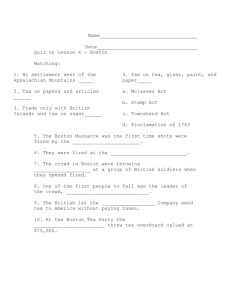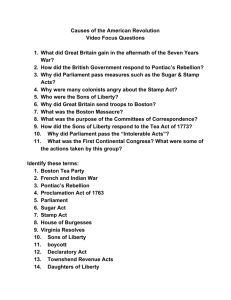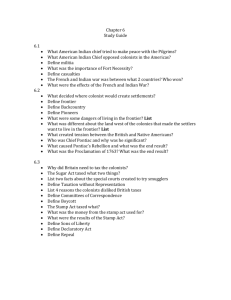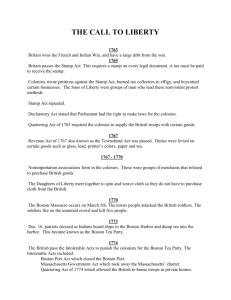America: A Concise History
advertisement
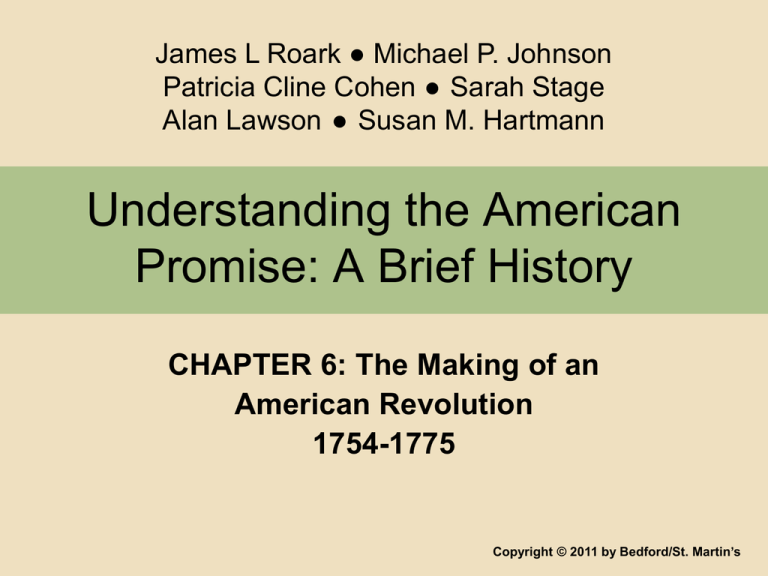
James L Roark ● Michael P. Johnson Patricia Cline Cohen ● Sarah Stage Alan Lawson ● Susan M. Hartmann Understanding the American Promise: A Brief History CHAPTER 6: The Making of an American Revolution 1754-1775 Copyright © 2011 by Bedford/St. Martin’s I. How did the Seven Years’ War lay the groundwork for colonial crisis? A. French-British Rivalry in the Ohio County • 1. New France territory challenged by PA and VA • 2. French build forts • 3. VA send G. Washington to warn French of VA claims • 4. French defeat Washington at “Fort Necessity” July 1754 B. The Albany Congress 1. British convene a colonial conference 2. Prime goal was to secure Mohawk help against French 3. Albany Plan of Union 4. No colonies, or the British, approved the Albany Plan C. The War and Its Consequences 1. Britain suffered in early fighting, 1755 - 1757 2. War became a global conflict; British success 3. Consequences The Treaty of of Paris: 1763 D. British Leadership, Pontiac’s Uprising, and the Proclamation of 1763 1. 1760 – King George III crowned 2. Ottawa chief Pontiac attacked British in northern Ohio 3. British issued law preventing settlement west of Appalachian Mountains II. Why did the American colonists find offense with the Sugar and Stamp Acts of 1763 – 1765? A. Grenville’s Sugar Act 1. Revenue Act of 1764 – lowered tax on French molasses 2. Stiffened penalties for smuggling 3. Generally a failure B. The Stamp Act 1. Feb. 1765 – tax on paper used for official documents 2. Administration delegated to Americans 3. Virtual representation C. Resistance Strategies 1. Political resistance 2. “Sons of Liberty” 3. Demonstrations D. Liberty and Property 1. Protests spread in the colonies – Stamp Act Congress 2. “Life, liberty, property” 3. Stamp Act repealed March 1766 4. Declaratory Act III. What were the colonial responses to the Townshend duties? A. The Townshend Duties 1. Revenue Act of 1767 - taxation through trade duties 2. Some revenue would pay salaries of royal governors 3. Massachusetts assembly led protest 4. Repealed 1770, except for tea tax B. Nonconsumption and the Daughters of Liberty 1. Nonconsumption and nonimportation 2. Daughters of Liberty – female cooperation 3. Success – imports fell by 40% C. Military Occupation and “Massacre” in Boston 1. Fall of 1768, British troops occupied Boston 2. Protest in Boston resulted in British soldiers killing five 3. Trial resulted in two manslaughter convictions, others acquitted The Boston Massacre IV. What led to the escalation of tensions after 1772? A. The Calm before the Storm 1. Trade boomed in 1770-71 2. Gaspee affair 3. Committees of correspondence The Boston Tea Party B. Tea in Boston Harbor 1. Tea Act of 1774 2. Reminder of Parliament’s claim to the power of taxation 3. Dec. 16, 1774 Boston Tea Party C. The Coercive Acts • • • • • • • 1. Punishment for the Boston Tea Party 2. The Quebec Act 3. Americans called all five the Intolerable Acts 4. A continental congress 5. Rural unrest 6. Powder Alarm 7. Preparation for a crisis E. The First Continental Congress • • • • 1. Philadelphia, September 1774 2. Declaration of rights 3. Committees of public safety 4. Agreed to meet in next May V. What were the varieties of domestic insurrections in 1774-1775? A. Lexington and Concord • 1. Gage’s surprise attack – April 19, 1775 • 2. Warning system • 3. Lexington • 4. Concord Events of 1774-1775 B. Rebelling against Slavery 1. Dunmore’s Proclamation 2. Ethiopian Regiment 3. Phillis Wheatley VI. What changes did Americans want in 1775? A. Rights as British citizens • 1. Self-taxation • 2. Live free of an occupying army • 3. Self-rule
